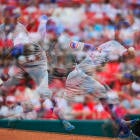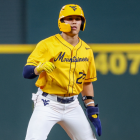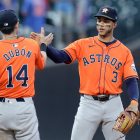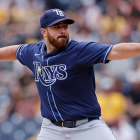CHICAGO -- One of baseball's recent true norths -- to invent a plural form -- is that commissioner Rob Manfred will tinker at the margins in order to improve pace of play, at least notionally, and re-calibrate a game that, according to sturdy consensus, has become too infested with strikeouts.
Manfred, for instance, has eliminated the four-pitch intentional walk in favor of a simple managerial command, reduced the break times between innings, put caps on mound visits, commanded hitters to (mostly) stay in the box, put a timer on pitching changes, and the like. A pitch clock seems likely to make its way to MLB, and Manfred is even beta-testing far more drastic initiatives this year in the independent Atlantic League. Among those is a requirement that pitchers face at least three batters, which is slated to become an MLB rule in 2020.
While the finest points have yet to be established, any pitcher will be required to face at least three batters or end the half-inning, with exceptions for injury or illness (and presumably with some measures to prevent tactical malingering). This of course strikes at the heart of the platoon-advantaged reliever. It also figures to snuff out one of baseball's most cherished informal acronyms: LOOGY (or, lefty one-out guy). Under the new three-batter rule, the lefty specialist will need to run up against a full inning's worth of left-handed bats in a row (unlikely), conclude a half-inning, or prove capable of taming the opposite side.
The thinking, of course, is that eliminating one- and two-batter relief appearances -- i.e., mid-inning pitching changes -- will whittle away at the game's remaining dead time and thus improve flow. In theory it makes a certain sense, but research shows that relief appearances that don't end a frame haven't really increased all that much. Much like the abbreviation of the intentional walk process, this could be a structural change that doesn't really accomplish much.
With that perhaps limited return in mind, it's worth pondering what other stakeholders in this process think about it. We speak of relievers in general and left-handed relievers in particular. "I'm fine with it personally. As far as a team perspective goes, I hate it," Caleb Frare of the White Sox recently told CBS Sports. "I feel like that strategy is a part of baseball, and I don't understand how you're going to tell playoff teams that you can't bring in a lefty to face a lefty or a righty to face a righty. I don't understand how you can justify that as good for the game."
That's a common refrain among relievers -- that it's going to be more of an issue for their managers than it will be for them. "As a manager, I don't know if it's going to simplify it or complicate it," Frare's teammate Jace Fry said.
That cuts to the heart of it. Some managers have lamented the loss of strategy that they feel is going to be a consequence of the new rule. Really, though, it's just being presented with different decisions to make. Deciding to go to the lefty for one out isn't really tactically challenging in the era of the eight- and even nine-man bullpen. But let's say a manager next season is opposing the Phillies and faced with the heart of the order while clinging to a slim late-inning lead with two outs. Bryce Harper is up. Does he summon the lefty? That would be an easy call under 2019 rules because you know Gabe Kapler isn't going to lift Harper for a righty bench bat. In 2020, however, you're taking a risk. If that lefty doesn't retire Harper to end the inning, he'll be tasked with ceding the platoon advantage to Rhys Hoskins and then J.T. Realmuto. Treacherous shoals, those. Maybe you summon the righty and intentionally walk Harper, but what if the bases are loaded? You can alter the hypothetical particulars and come up with a number of scenarios that challenge tactics in ways the current rules don't. Strategy won't be lost; it will be altered.
"I think managing a bullpen and having select pitchers for certain hitters is kind of the way the game is shaped," Mariners Rule 5 pick and right-hander Brandon Brennan said. "That's why it'll be interesting to see how coaches go about bullpen usage at that point."
It will be interesting, and it's an outgrowth of that change in strategy. Will bullpens get smaller with a focus on length as opposed to matchups? That, in turn, would strengthen benches around the league, which would in turn present even more late-inning challenges to managers.
The other, greater consideration is how it affects the pitchers themselves. Yankees reliever Dellin Betances recently worried aloud that pitching on consecutive days under the forthcoming rule could exact a price in terms of pitcher health. For his part, veteran Cubs reliever Steve Cishek, who says he opposes the rule change, agrees. "I threw a lot last year, but sometimes I was maybe able to face just one hitter," Cishek told CBS Sports. "Those back-to-back days aren't going to be the same anymore, where you could pitch two or three days in a row. It's going to be tough to do unless by some great circumstance you get guys to get early outs every single outing, which isn't realistic. If you're going up there with 15 to 25 pitches facing three batters a day, you're trying to go back-to-back over the whole season or even three games in a row, it's gonna hurt a little bit."
In terms of roles, Brennan wondered aloud whether we'll see any more specialists in the bullpen. Specialty usage will probably survive in very limited fashion (with two outs in an inning and a same-side star hitter up, to repeat the example laid out above), but that will be a secondary role. Pitchers like Fry, who have an uncommonly deep repertoire for lefty relievers, won't have as much trouble adapting to an expanded role. Others, though, may need to tinker.
"Maybe develop a changeup, something to use against righties," said Seattle lefty Zac Rosscup when asked about the three-batter rule. "I haven't really thought about it too much. My hopes are that it doesn't happen."
If you're fastball-sinker-slider or something close to it, then you lack a true platoon-busting second pitch, and that describes a lot of lefty relievers. As well, even in his era of shrunken benches, pretty much every team has a spare right-handed bat to counter lefty relievers in the middle to late innings. "They say they want to speed up the game, and that makes sense to an extent," Rosscup mused. "But if you have lefties facing more righties, and those guys statistically are going to get on base more, you know, it's going to take longer to get the three outs. I guess it goes both ways. If we can adapt to it, I guess it speeds up the game. "
There's the key. Seemingly, game time and pace of play get conflated even though they're not the same things, and Manfred's near obsession with the three-hour mark for average game times contributes to that perception. Eliminating mid-inning pitching changes helps pace, but does it necessarily lead to shorter run times if the outs don't come as easily? As Rosscup says, the best way to eliminate that unknown is for imperiled lefties to make the necessary adjustments. Obviously, that's easier said than done.
Some element of niche duty will be lost, and left-handers in particular may face challenges when it comes to keeping their roster spots. The lefty changeup may be coveted in the bullpen starting next offseason, and the same goes for higher arm angles (less prone to platoon weaknesses). Durability -- always at a premium with pitchers -- may become even more of one in the bullpen. As is the case with any major structural change, teams will adapt by finding the players -- and maybe even the managers -- who themselves adapt.


















